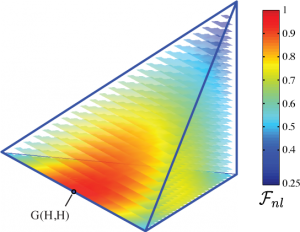Quantum Matchgates
Today, New Journal of Physics has published our paper “Matchgate quantum computing and non-local process analysis“.
Matchgates are an intriguing class of two-qubit quantum logic gates. Circuits built up solely by matchgates, acting on neighbouring qubits, are efficiently simulatable classically. If the gates are however, allowed to act on any two qubits, which can be achieved by a simple two-qubit SWAP, they allow universal quantum computing.
In our paper we show a simple decomposition of the somewhat mystic matchgates into gates that are better known, such as single-qubit unitaries, and 2-qubit CNOT gates and controlled-unitaries. We then implement the only non-trivial matchgate needed for universal matchgate computing—the so called G(H,H) gate—with single photons and linear optics.

In the second part of the paper, we analyze the resulting quantum process in a novel way. We calculate 3-dimensional fidelity maps which show the overlap, maximized over local operations, between a unitary projection of our experimental process and all possible non-local 2-qubit operators, parametrized in the so-called Weyl chamber. In order to understand what that means, you’d have to be really interested in this sort of thing and read the paper. What it allows us to do is, first of all, to identify error sources in our process. Second, we can create pretty pictures (see figure on the right) which give us insight into the non-local properties of our process which would not be immediately obvious from standard process analysis tools.
This work was done in collaboration with Sven Ramelow and Aephraim Steinberg, who both happened to visit us some time ago.
1 thought on “Quantum Matchgates”